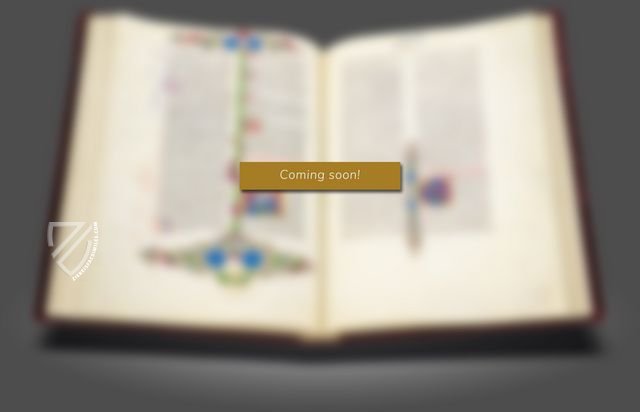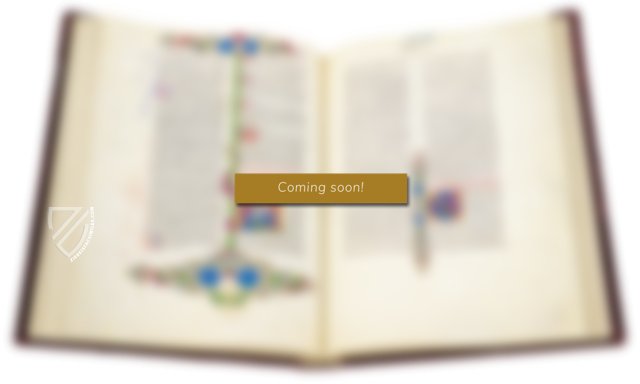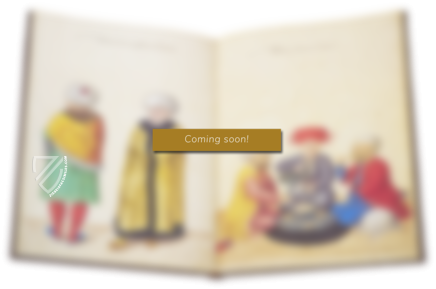Codex Alexandrinus
This 5th century manuscript of the Greek Bible is one of the most precious books to survive to the present day and constitutes one of the oldest and most complete specimens of the Bible alongside the Codex Sinaiticus and Codex Vaticanus. Its Greek uncial text is neatly written in two columns and the codex also boasts some of the earliest known colophons with volutes and other decorative tailpieces. The manuscript is presumed to have originated from the Eastern Mediterranean and is named after the city of Alexandria, where it resided for centuries before being taken to Constantinople by Patriarch Cyril Lucaris in 1621. It was then gifted to King Charles I of England in 1627 and was incorporated into a 1657 polyglot Bible juxtaposing passages from the Bible in parallel columns and was given the primary position to emphasis its authority. Today, the Codex Alexandrinus is counted among the most prized possessions of the British Library’s prestigious collections.
Codex Alexandrinus
Named after the city of Alexandria in which it was stored for centuries, the Codex Alexandrinus was the first ancient manuscript of great importance to be extensively studied by textual scholars and philologists. It is counted among the so-called “four great uncial codices”, the only surviving Greek Bibles that contain or originally contained the Old and New Testaments in their entirety, which also include the Codex Vaticanus, Codex Sinaiticus, and Codex Ephraemi. These four manuscripts are considered to be authoritative for the creation of any modern translation of the Bible, especially regarding the New Testament.
The Codex Alexandrinus was made about a century later than the others and is the only one to feature any ornamentation but is otherwise similar in design to the rest of the group leading to speculation that they originated from the same scriptorium in the Eastern Mediterranean. It contains a nearly complete copy of the Old Testament, including the deuterocanonical books, and all of the New Testament save for the first few pages for the Book of Matthew as well as various other apocryphal works.
Created by Professional Scribes, but Where?
Like the other three great uncial codices, the Codex Alexandrinus is obviously the work of professional scribes who were well-practiced in their trade but any other details concerning its provenance can only be guessed at based on clues in the text. Paleographers have dated the manuscript to the 5th century by comparing the style of its writing with other specimens. It has traditionally been hypothesized that a scriptorium once under the direction of the famous biblical scholar Eusebius in Caesarea, Palestine could be the common point of origin for all of these manuscripts. However, other scholars have argued that the Codex Alexandrinus could easily have been created in Alexandria itself, which was still an important center of learning and culture.
The manuscript was neatly written in two columns on 773 vellum folios of the highest quality; the opening lines of each book written in red ink and the end of each book is marked by a colophon with decorative tailpieces. An enlarged letter marks the beginning of each sentence and the Codex Alexandrinus is also the oldest manuscript to use enlarged letters to indicate new sections. Originally arranged into four volumes – three for the Old Testament and one for the New – it was later rebound into a single codex. The Gospels are the oldest specimen of the Byzantine text-type while the rest of the New Testament is written in the Alexandrian text-type. Regardless of where exactly it was created, the manuscript is a testament to the prolific manuscript culture of Late Antiquity.
From Alexandria to Constantinople to London
After centuries in Alexandria, perhaps more than a millennium, the manuscript was brought to Constantinople by the Patriarch of Alexandria, Cyril Lucaris (1572–1638), upon his elevation to the See of Constantinople. Lucaris, the first to suggest the manuscript originated in Alexandria, became deeply involved in the politics of the Ottoman capital and was temporarily banished or deposed several times due to the machinations of his enemies in the Orthodox Church, who opposed his efforts to reform the Church along Calvinists principles, as well complaints from French and Austrian Ambassadors. At the same time, he enjoyed support from the ambassadors of Protestant countries such as England and the Netherlands.
In gratitude, Lucaris presented the manuscript to the English ambassador Sir Thomas Roe (ca. 1581–1644) in 1624 as a gift to King James I, but the King died the following year before the manuscript reached him. The manuscript was finally received by James’ son and heir, King Charles I (1600–49), in 1627. It was critical for the creation of the 1657 *London Polyglot Bible by Bishop Brian Walton (1600–61), widely regarded as the last great polyglot. Walton assigned the Codex Alexandrinus with the letter “A” and the first position in the multilingual work juxtaposing biblical passages in different languages including Syriac, Persian, and Ethiopic.
Codicology
- Size / Format
- 779 folios / 32.0 × 28.0 cm
- Origin
- Cyprus
- Date
- Ca. 400
- Epochs
- Style
- Genre
- Language
- Script
- Greek Uncial
- Illustrations
- Rubrics and initials
- Content
- Complete Bible, originally divided into 4 separate volumes
- Previous Owners
- Athansius III
Cyril Lucar
Thomas Roe
Charles I
Old Royal Library
#1 The Codex Alexandrinus
Language: English
- Treatises / Secular Books
- Apocalypses / Beatus
- Astronomy / Astrology
- Bestiaries
- Bibles / Gospels
- Chronicles / History / Law
- Geography / Maps
- Saints' Lives
- Islam / Oriental
- Judaism / Hebrew
- Single Leaf Collections
- Leonardo da Vinci
- Literature / Poetry
- Liturgical Manuscripts
- Medicine / Botany / Alchemy
- Music
- Mythology / Prophecies
- Psalters
- Other Religious Books
- Games / Hunting
- Private Devotion Books
- Other Genres
- Afghanistan
- Armenia
- Austria
- Belgium
- Belize
- Bosnia and Herzegovina
- China
- Colombia
- Costa Rica
- Croatia
- Cyprus
- Czech Republic
- Denmark
- Egypt
- El Salvador
- Ethiopia
- France
- Germany
- Greece
- Guatemala
- Honduras
- Hungary
- India
- Iran
- Iraq
- Israel
- Italy
- Japan
- Jordan
- Kazakhstan
- Kyrgyzstan
- Lebanon
- Liechtenstein
- Luxembourg
- Mexico
- Morocco
- Netherlands
- Palestine
- Panama
- Peru
- Poland
- Portugal
- Romania
- Russia
- Serbia
- Spain
- Sri Lanka
- Sweden
- Switzerland
- Syria
- Tajikistan
- Turkey
- Turkmenistan
- Ukraine
- United Kingdom
- United States
- Uzbekistan
- Vatican City
- A. Oosthoek, van Holkema & Warendorf
- Aboca Museum
- Ajuntament de Valencia
- Akademie Verlag
- Akademische Druck- u. Verlagsanstalt (ADEVA)
- Aldo Ausilio Editore - Bottega d’Erasmo
- Alecto Historical Editions
- Alkuin Verlag
- Almqvist & Wiksell
- Amilcare Pizzi
- Andreas & Andreas Verlagsbuchhandlung
- Archa 90
- Archiv Verlag
- Archivi Edizioni
- Arnold Verlag
- ARS
- Ars Magna
- ArtCodex
- AyN Ediciones
- Azimuth Editions
- Badenia Verlag
- Bärenreiter-Verlag
- Belser Verlag
- Belser Verlag / WK Wertkontor
- Benziger Verlag
- Bernardinum Wydawnictwo
- BiblioGemma
- Biblioteca Apostolica Vaticana (Vaticanstadt, Vaticanstadt)
- Bibliotheca Palatina Faksimile Verlag
- Bibliotheca Rara
- Boydell & Brewer
- Bramante Edizioni
- Bredius Genootschap
- Brepols Publishers
- British Library
- C. Weckesser
- Caixa Catalunya
- Canesi
- CAPSA, Ars Scriptoria
- Caratzas Brothers, Publishers
- Carus Verlag
- Casamassima Libri
- Centrum Cartographie Verlag GmbH
- Chavane Verlag
- Christian Brandstätter Verlag
- Circulo Cientifico
- Club Bibliófilo Versol
- Club du Livre
- CM Editores
- Collegium Graphicum
- Collezione Apocrifa Da Vinci
- Comissão Nacional para as Comemorações dos Descobrimentos Portugueses
- Coron Verlag
- Corvina
- CTHS
- D. S. Brewer
- Damon
- De Agostini/UTET
- De Nederlandsche Boekhandel
- De Schutter
- Deuschle & Stemmle
- Deutscher Verlag für Kunstwissenschaft
- DIAMM
- Droz
- E. Schreiber Graphische Kunstanstalten
- Ediciones Boreal
- Ediciones Grial
- Ediclube
- Edições Inapa
- Edilan
- Editalia
- Edition Deuschle
- Edition Georg Popp
- Edition Leipzig
- Edition Libri Illustri
- Editiones Reales Sitios S. L.
- Éditions de l'Oiseau Lyre
- Editions Medicina Rara
- Editorial Casariego
- Editorial Mintzoa
- Editrice Antenore
- Editrice Velar
- Edizioni Edison
- Egeria, S.L.
- Eikon Editores
- Electa
- Emery Walker Limited
- Enciclopèdia Catalana
- Eos-Verlag
- Ephesus Publishing
- Ernst Battenberg
- Eugrammia Press
- Extraordinary Editions
- Fackelverlag
- Facsimila Art & Edition
- Facsimile Editions Ltd.
- Facsimilia Art & Edition Ebert KG
- Faksimile Verlag
- Feuermann Verlag
- Folger Shakespeare Library
- Franco Cosimo Panini Editore
- Friedrich Wittig Verlag
- Fundación Hullera Vasco-Leonesa
- G. Braziller
- Gabriele Mazzotta Editore
- Gebr. Mann Verlag
- Gesellschaft für graphische Industrie
- Getty Research Institute
- Giovanni Domenico de Rossi
- Giunti Editore
- Graffiti
- Grafica European Center of Fine Arts
- Guido Pressler
- Guillermo Blazquez
- Gustav Kiepenheuer
- H. N. Abrams
- Harrassowitz
- Harvard University Press
- Helikon
- Hendrickson Publishers
- Henning Oppermann
- Herder Verlag
- Hes & De Graaf Publishers
- Hoepli
- Holbein-Verlag
- Houghton Library
- Hugo Schmidt Verlag
- Idion Verlag
- Il Bulino, edizioni d'arte
- ILte
- Imago
- Insel Verlag
- Insel-Verlag Anton Kippenberger
- Instituto de Estudios Altoaragoneses
- Instituto Nacional de Antropología e Historia
- Introligatornia Budnik Jerzy
- Istituto dell'Enciclopedia Italiana - Treccani
- Istituto Ellenico di Studi Bizantini e Postbizantini
- Istituto Geografico De Agostini
- Istituto Poligrafico e Zecca dello Stato
- Italarte Art Establishments
- Jan Thorbecke Verlag
- Johnson Reprint Corporation
- Josef Stocker
- Josef Stocker-Schmid
- Jugoslavija
- Karl W. Hiersemann
- Kasper Straube
- Kaydeda Ediciones
- Kindler Verlag / Coron Verlag
- Kodansha International Ltd.
- Konrad Kölbl Verlag
- Kurt Wolff Verlag
- La Liberia dello Stato
- La Linea Editrice
- La Meta Editore
- Lambert Schneider
- Landeskreditbank Baden-Württemberg
- Leo S. Olschki
- Les Incunables
- Liber Artis
- Library of Congress
- Libreria Musicale Italiana
- Lichtdruck
- Lito Immagine Editore
- Lumen Artis
- Lund Humphries
- M. Moleiro Editor
- Maison des Sciences de l'homme et de la société de Poitiers
- Manuscriptum
- Martinus Nijhoff
- Maruzen-Yushodo Co. Ltd.
- MASA
- Massada Publishers
- McGraw-Hill
- Metropolitan Museum of Art
- Militos
- Millennium Liber
- Müller & Schindler
- Nahar - Stavit
- Nahar and Steimatzky
- National Library of Wales
- Neri Pozza
- Nova Charta
- Oceanum Verlag
- Odeon
- Orbis Mediaevalis
- Orbis Pictus
- Österreichische Staatsdruckerei
- Oxford University Press
- Pageant Books
- Parzellers Buchverlag
- Patrimonio Ediciones
- Pattloch Verlag
- PIAF
- Pieper Verlag
- Plon-Nourrit et cie
- Poligrafiche Bolis
- Presses Universitaires de Strasbourg
- Prestel Verlag
- Princeton University Press
- Prisma Verlag
- Priuli & Verlucca, editori
- Pro Sport Verlag
- Propyläen Verlag
- Pytheas Books
- Quaternio Verlag Luzern
- Reales Sitios
- Recht-Verlag
- Reichert Verlag
- Reichsdruckerei
- Reprint Verlag
- Riehn & Reusch
- Roberto Vattori Editore
- Rosenkilde and Bagger
- Roxburghe Club
- Salerno Editrice
- Saltellus Press
- Sandoz
- Sarajevo Svjetlost
- Schöck ArtPrint Kft.
- Schulsinger Brothers
- Scolar Press
- Scrinium
- Scripta Maneant
- Scriptorium
- Shazar
- Siloé, arte y bibliofilia
- SISMEL - Edizioni del Galluzzo
- Sociedad Mexicana de Antropología
- Société des Bibliophiles & Iconophiles de Belgique
- Soncin Publishing
- Sorli Ediciones
- Stainer and Bell
- Studer
- Styria Verlag
- Sumptibus Pragopress
- Szegedi Tudomànyegyetem
- Taberna Libraria
- Tarshish Books
- Taschen
- Tempus Libri
- Testimonio Compañía Editorial
- Thames and Hudson
- The Clear Vue Publishing Partnership Limited
- The Facsimile Codex
- The Folio Society
- The Marquess of Normanby
- The Richard III and Yorkist History Trust
- Tip.Le.Co
- TouchArt
- TREC Publishing House
- TRI Publishing Co.
- Trident Editore
- Tuliba Collection
- Typis Regiae Officinae Polygraphicae
- Union Verlag Berlin
- Universidad de Granada
- University of California Press
- University of Chicago Press
- Urs Graf
- Vallecchi
- Van Wijnen
- VCH, Acta Humaniora
- VDI Verlag
- VEB Deutscher Verlag für Musik
- Verlag Anton Pustet / Andreas Verlag
- Verlag Bibliophile Drucke Josef Stocker
- Verlag der Münchner Drucke
- Verlag für Regionalgeschichte
- Verlag Styria
- Vicent Garcia Editores
- W. Turnowski Ltd.
- W. Turnowsky
- Waanders Printers
- Wiener Mechitharisten-Congregation (Wien, Österreich)
- Wissenschaftliche Buchgesellschaft
- Wissenschaftliche Verlagsgesellschaft
- Wydawnictwo Dolnoslaskie
- Xuntanza Editorial
- Zakład Narodowy
- Zollikofer AG








